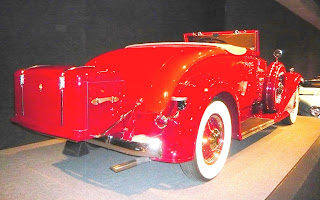Packard
"Ask the man
who owns one”
1933 Packard Eight Coupe Roadster
Not many years after it’s
founding in 1899, Packard Motor Car Company established itself as
America's premier fine car maker, as it claimed over 50% of the luxury market by the time the “Tenth
Series” was introduced in 1933 as “the greatest Packards ever built.”
However, the
Depression brought with it slumping sales of luxury cars but Packard hoped to
increase sales by stretching the product line into three distinct groups– the
Eight, the Super Eight, and the Twelve.
Even as Packard's
entry-level model, the Eight was still well and truly a full luxury car. With a
320-cubic inch 120-horsepower aluminum-‘L’ head straight-8 cylinder engine with
down-draft carburetor and full synchronized transmission, the 1933 Packard Eight
provided exceptional performance and was considered a performance car of the
era for those who could afford them.
The sales price for the 1933 Packard Eight series automobile started at $2,150,
at a time when the average family earned $2,956 annually in taxable income, and for comparison, a
new 1936 Plymouth Six sold for $445.
Fewer than
5,000 examples of the “Tenth Series” Packard were produced and of that total, only 1800 Packard Eights were built, spread over fourteen different body styles.
As displayed at the Blackhawk Museum, this two-tone
red 4-passenger Coupe Roadster, a body style which was offered only in 1933, rides on a 127-1/2 inch wheelbase features a rumble
seat, side-mounted spare tire, white wall tires and Trippe driving lights.
Trippe lights, sold and installed by Packard dealers, were mounted on the bumper bar and were
fixed as opposed to the more expensive “self-steering” Pilot Ray lights which moved
in concert with the with the front wheels through a series of linkages
This
car, which was listed for sale for $325,000, previously received the
Classic Car Club of America (CCCA) National First Place Award and a 100-point
Senior Award.
1934 Packard
Super Eight Dual Cowl Sport Phaeton
In 1934, Packard introduced the “Eleventh Series” which maintained the three distinct
products lines – the Eight, the Super Eight and the Twelve. This car also
displayed at the Blackhawk Museum is a Super Eight, ,shared the same
chassis as the twelve-cylinder cars, and in the case of this car, rides on a
142-inch wheelbase.
This car is
powered by the Packard 385-cubic inch straight eight cylinder L-head engine
with aluminum alloy pistons that produced 145 horsepower connected to a
three-speed synchro-mesh transmission. Packard factory literature indicated
that customers could expect to travel ten miles per gallon of gasoline under
average conditions.
Before leaving the factory 'Super Eight 'engines were run-in
with an electric motor for nine hours then run on a dynamometer for one hour and
15 minutes. After the engine was installed in the chassis, the car was given a
road test at the Packard Proving Grounds
The striking
four-passenger deluxe dual-cowl sport phaeton body was built in the 22-acre
body plant inside the mile-long Packard factory. As is typical of the era, this is not an
all-steel body rather kiln-dried hardwoods are used for the supporting
structure of the 19-gauge (7/16th inch) steel body panels. Packard literature
stated that a composite body was lighter than an equivalent all-steel body and
less prone to rattles and squeaking.
This car, retailed from the factory for a base price of $3,440 is equipped with chrome
plated wire wheels which sold for $32 each and a pair of side-mounted tire
mirrors at $16 for the pair.
The dual
trumpet horns were a standard feature introduced for the eleventh series, and
the new-for-1934 fender lights are mounted on the redesigned eleventh series
fenders with improved gutter construction on the underside of the fender to
prevent water being thrown up at high speeds.
Packard Motor
Car survived the Depression and emerged from World War Two production in solid
financial condition, but management made some key mistakes by using the same
styling on the lower and upper priced models.
Packard continued to lead in fine
car sales until 1950, but as the decade of the nineteen fifties continued, Packard sales declined perhaps because Packard still offered
straight eight engines while the market had moved onto V-8 engines.
In 1954
Packard merged with Studebaker but that marriage proved disastrous, with the
last “true” Packard was built in Detroit in June 1956, and the Packard brand
name disappeared altogether in 1959.





It's always wonderful to stop by your blog for your detailed history on various vehicle companies. There is so much informative information and I enjoy every thing I learn from your articles. Have a great rest of your day.
ReplyDeleteLawyer